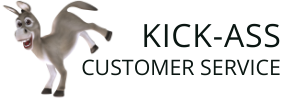Proactive Customer Service Reduces Customer Service Fires
Spending too much time putting out “customer service fires”? Proactive customer service is the solution.
Putting out “customer service fires” is something all businesses do. Yet many businesses — yours, for example? — spend way too much time extinguishing “customer service fires.” Time that could be spent on cultivating — instead of consoling — your customers. The good news is that there is a solution: it’s called proactive customer service.
Why does this matter? In The 7 Habits of Highly Effective People: Powerful Lessons in Personal Change, author Steven R. Covey talks about a time management grid. The time management grid prioritizes how you should spend your time on activities that advance your goals.
- Urgent activities require your immediate attention, like putting out “customer service fires.”
- Non-urgent activities require your attention, but not your immediate attention, like preventing “customer service fires.”
Covey says that the more time you spend on non-urgent activities, the less time you spend on urgent activities. Think of it this way:
- Urgent activities are reactive.
- Non-urgent activities are proactive.
In other words, putting out “customer service fires” is an urgent reactive activity, but preventing “customer service fires” is a non-urgent proactive activity. Simply put, the key to minimizing “customer service fires” is to spend more time in proactive customer service.
Here are three practical, yet simple, proactive customer service strategies.
Overcommunicate with Customers
Don’t just communicate with your customers — overcommunicate with them.
For example, overcommunicate:
- Expectations — especially the boundaries of guarantees and promises.
- Terms and conditions — especially the “fine print.”
- Any information that customers might not understand — especially common misperceptions.
Sharpen Customer Service Processes
Continuously refine your processes to provide a streamlined customer service experience. In other words, eliminate customer service bottlenecks.
Examples of common customer service bottlenecks include:
- Bouncing customers from one department to another.
- Failing to resolve customer service issues during the initial call.
- Requiring front-line customer service team members to obtain approval from managers.
Customer service processes that eliminate customer service bottlenecks tend to:
- Streamline the customer service experience.
- Prevent customers from having to call back.
- Empower front-line customer service team members.
Train! And then train even more!
Ongoing training is also a a big part of proactive customer service. Without continuous training, even the most effective processes lose their potency.
Guess who does this the best? Think about it. Airline pilots and flight attendants receive intense training with respect to both “normal” (preventive) and “emergency” (reactive) procedures. And the training is continuous, not just sporadic.
Businesses that use a similar approach toward customer service tend to be customer service powerhouses because those businesses realize that training isn’t just limited to onboarding new employees.
This sounds reasonable, you’re thinking, but how can your business create effective customer service processes? That’s an excellent question, and in the future we’ll share some practical strategies that your business or organization can use to create effective customer service processes.
In the meantime, have a customerific week!
If you like short articles like these about customer service tips and strategies, consider subscribing to our Kick-Ass Customer Service Newsletter, which is delivered directly to your inbox.
Mark
